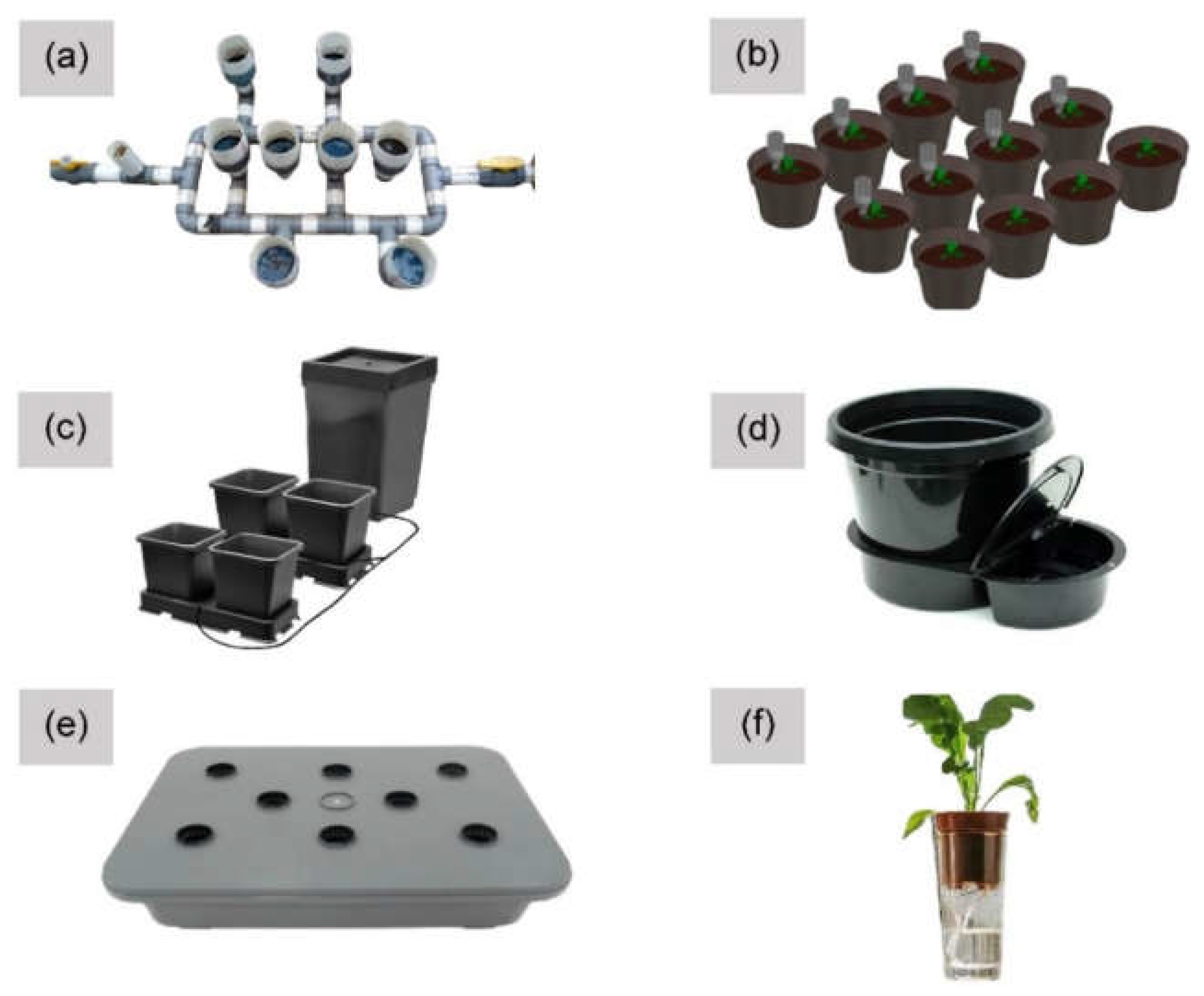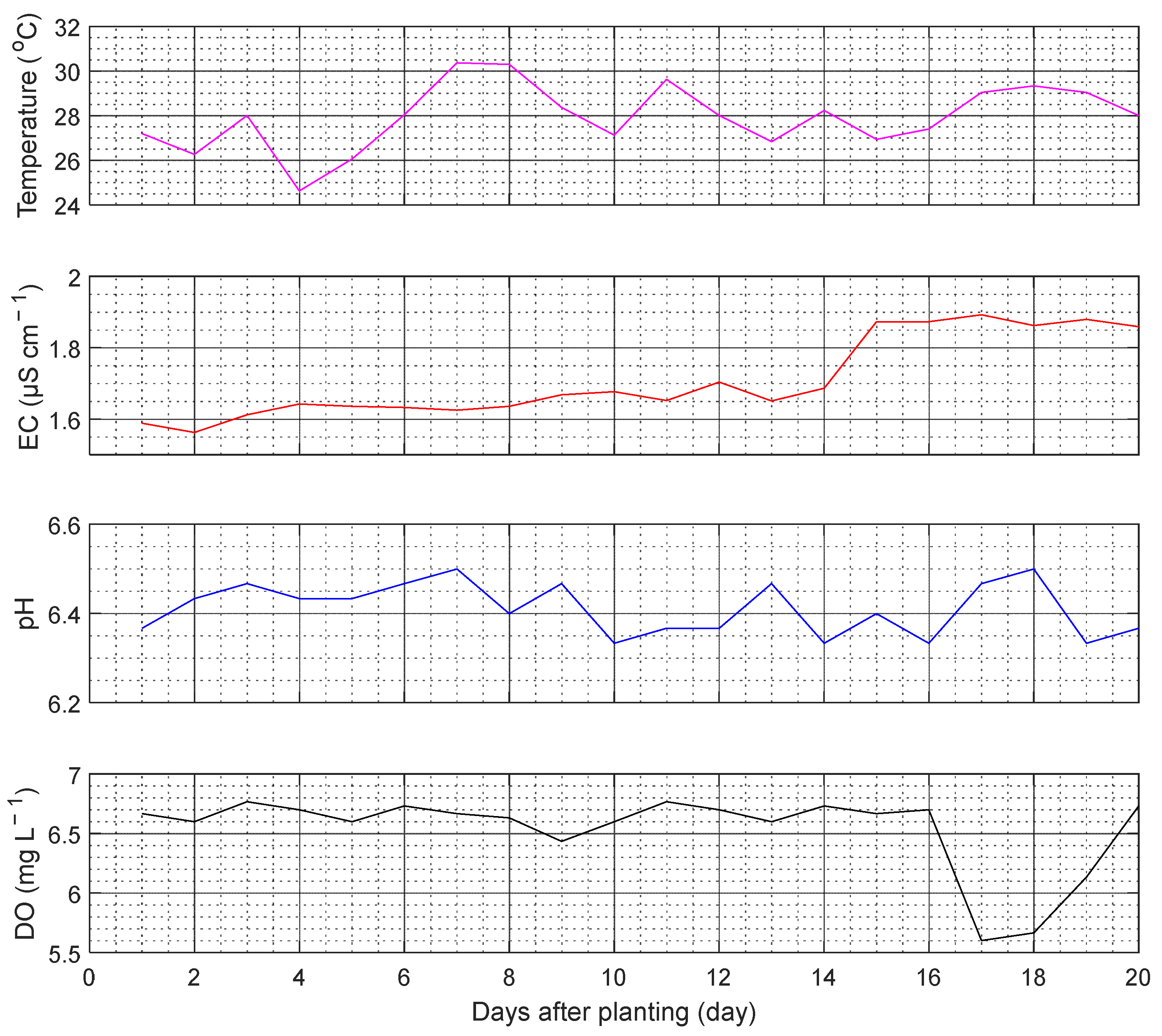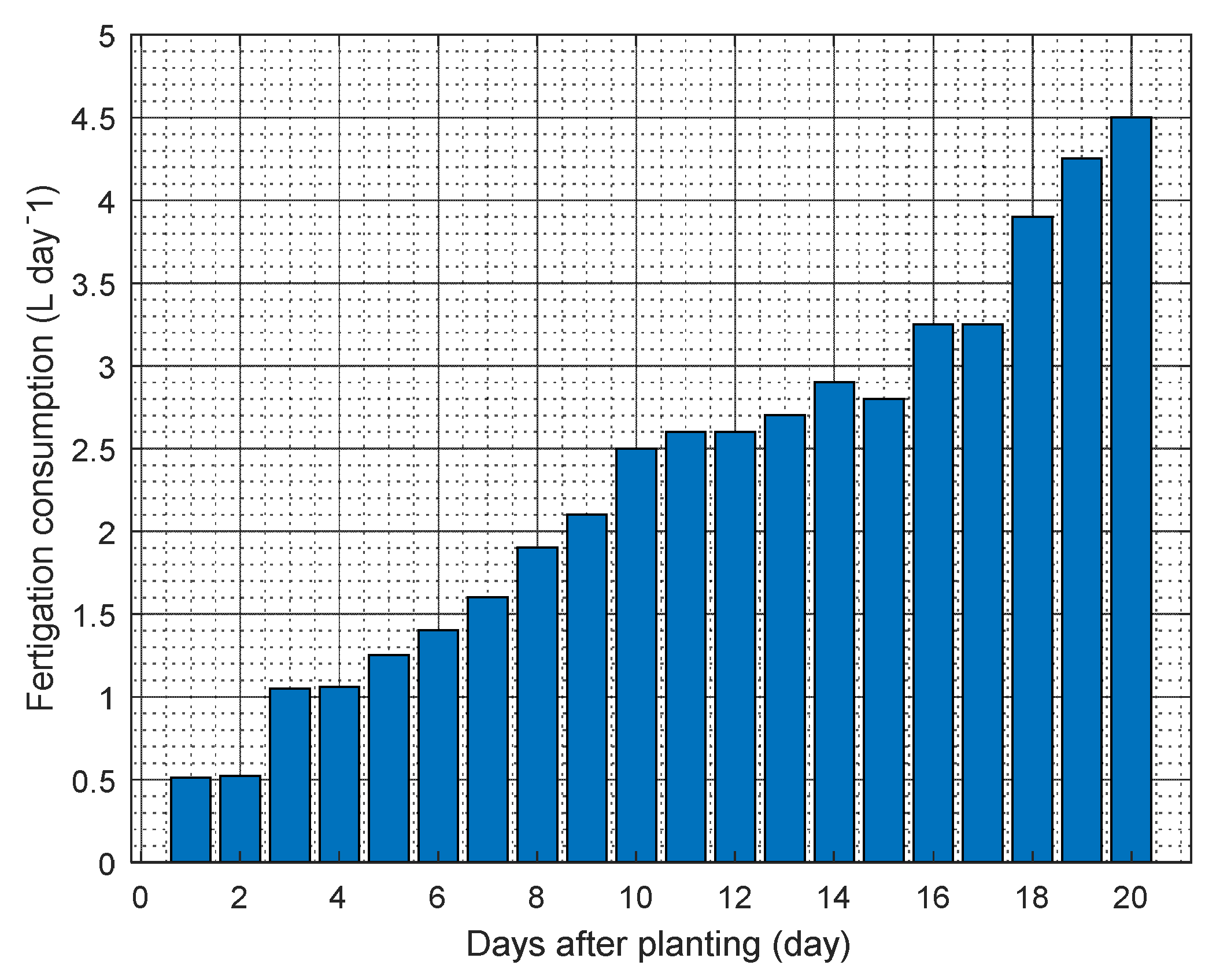The Modified Hydroponic Kit Based on Self-Fertigation System Designed for Remote Areas
Abstract
1. Introduction
2. Materials and Methods
2.1. Location
2.2. Horticulture Cultivation
2.3. Microclimate Conditions
2.4. The Modified Hydroponic Kit
2.5. The Hydroponic Kit Evaluation
2.5.1. Fertigation Quality
2.5.2. Fertigation Consumption
2.6. Crop Performance
2.6.1. Growth and Yield
2.6.2. Nutritional Quality Index
- Vitamin C
- 2.
- Calcium
- 3.
- Potassium
- 4.
- Magnesium
- 5.
- Iron
- 6.
- Phosphor
2.7. Data Analysis and Statistics
3. Results and Discussion
3.1. The Modified Hydroponic Kit Evaluation
3.2. Morphological and Nutritional
4. Conclusions
Author Contributions
Funding
Data Availability Statement
Acknowledgments
Conflicts of Interest
References
- The World Bank. Prevalence of Undernourishment. Available online: https://data.worldbank.org/indicator/SN.ITK.DEFC.ZS (accessed on 2 September 2022).
- The United Nations. Food. Available online: https://www.un.org/ (accessed on 2 September 2022).
- Putra, E.S.; Jamaludin, J.; Djatmiko, M.D. Comparation of hydroponic system design for rural communities in Indonesia. J. Arts Humanit. 2018, 7, 14–21. [Google Scholar]
- Gong, L.; Chen, G.; Li, J.; Zhu, G. Utilization of rural domestic sewage tailwaters by Ipomoea aquatica in different hydroponic vegetable and constructed wetland systems. Water Sci. Technol. 2020, 82, 386–400. [Google Scholar] [CrossRef] [PubMed]
- Gumisiriza, M.S.; Ndakidemi, P.; Nalunga, A.; Mbega, E.R. Building sustainable societies through vertical soilless farming: A cost-effectiveness analysis on a small-scale non-greenhouse hydroponic system. Sustain. Cities Soc. 2022, 83, 103923. [Google Scholar] [CrossRef]
- Sowmya, B.; Seema, S.; HR, C.G.; Raghu, A.; Shastry, A.O.; Nikith, O.; Srinivasa, K. Computer Vision and IoT-Based Automated Hydroponic Farms in Urban Areas: A Soilless Cultivation. Int. J. Soc. Ecol. Sustain. Dev. 2022, 13, 1–21. [Google Scholar] [CrossRef]
- Atamurodov, B.; Sobirov, K.; Najmiddinov, M. Development of Irrigation Procedures by the Method of Hydroponics. Am. J. Soc. Hum. Res. 2022, 3, 40–44. [Google Scholar]
- Basir, M.H.; Masri, I.N. Effect of Light Emitting Diode (LED) Spectrum at Seedlings Production for Optimal Growth on Different Type of Lettuce in MARDI Plant Factory. Adv. Agri. Food Res. J. 2021, 2, 1–11. [Google Scholar] [CrossRef]
- Andrea. How Much Hydroponics Cost? [Bills and Real Case Example]. Available online: https://www.yourindoorherbs.com/how-much-hydroponics-cost-bills/ (accessed on 4 July 2022).
- Dewi, V.A.K.; Setiawan, B.I.; Minasny, B.; Waspodo, R.S.B. Performance of closed-type irrigation system at a greenhouse. Agric. Eng. Int. CIGR J. 2020, 22, 58–64. [Google Scholar]
- Arif, C.; Wibisono, Y.; Nugroho, B.D.A.; Saputra, S.F.D.; Malik, A.; Setiawan, B.I.; Mizoguchi, M.; Ardiansyah, A. Functional Design of Pocket Fertigation under Specific Microclimate and Irrigation Rates: A Preliminary Study. Agronomy 2022, 12, 1362. [Google Scholar] [CrossRef]
- Autopot. The “Plant Driven” Concept—To Each According to Its Needs. Available online: https://www.autopot.com.au/ (accessed on 19 March 2022).
- City Farm. Kratky Method 8 Cell Kit. Available online: https://cityfarm.my/products/kratky-method-8-cell-kit (accessed on 4 July 2022).
- Kurnia. Panduan Cara membuat Starter Kit Hidroponik Sistem Wick Terlengkap. Available online: https://blogidn.com/tag/sistem-hidroponik/ (accessed on 4 July 2022).
- Indonesian Agency for Meteorological, C.A.G. Weather Forecast. Available online: https://www.bmkg.go.id/ (accessed on 9 July 2022).
- Rotach, M.; Calanca, P. Microclimate. In Encyclopaedia of Atmospheric Sciences; Elsevier: Amsterdam, The Netherlands, 2002; pp. 1301–1307. [Google Scholar]
- Nabilah, R.A.; Pratiwi, A. Pengaruh pupuk organik cair kulit buah pisang kepok (Musa paradisiaca L. var. balbisina colla.) terhadap pertumbuhan tanaman bayam (Amaranthus gracilis Desf). In Proceedings of the Symposium of Biology Education (Symbion), Yogyakarta, Indonesia, 31 August 2019. [Google Scholar]
- Suarjana, I.M.; Aviantara, I.G.N.A.; Arda, G. Pengaruh jarak tanam terhadap pertumbuhan dan hasil tanaman bayam (Ammaranthus tricolor) secara hidroponik NFT (Nutrient Film Technique). J. BETA (Biosistem dan Teknik Pertanian) 2019, 8, 62–70. [Google Scholar] [CrossRef]
- Baras, T. Home Hydroponics: Small-space DIY Growing Systems; Cool Springs Press: Beverly, Massachusetts, USA, 2021. [Google Scholar]
- Pakari, A.; Ghani, S. Airflow assessment in a naturally ventilated greenhouse equipped with wind towers: Numerical simulation and wind tunnel experiments. Energy Build. 2019, 199, 1–11. [Google Scholar] [CrossRef]
- El-Ishaq, A.; Obirinakem, S. Effect of temperature and storage on vitamin C content in fruits juice. Int. J. Chem. Biochem. 2015, 1, 17–21. [Google Scholar]
- SNI 06-6989.56-2005; Air Dan Air Limbah—Bagian 56: Cara uji Kadar Kalsium (Ca) Dengan Spektrofotometer Serapan Atom (SSA). SNI (Indonesian National Standard): Jakarta Pusat, Indonesia, 2005.
- SNI 6989.69:2009; Air Dan Air Limbah—Bagian 69: Cara uji Kalium (K) Secara Spektrofotometri Serapan Atom (SSA)—Nyala. SNI (Indonesian National Standard): Jakarta Pusat, Indonesia, 2009.
- SNI 06-6989.12-2004; Cara uji Kesadahan Total Kalsium (Ca) Dan Magnesium (Mg) Dengan Metode Titrimetri. SNI (Indonesian National Standard): Jakarta Pusat, Indonesia, 2004.
- SNI 6989.4:2009; Air dan air limbah: Cara uji Besi (Fe) Secara Spektrofotometri Serapan Atom (SSA)—Nyala. SNI (Indonesian National Standard): Jakarta Pusat, Indonesia, 2009.
- SNI 06-6989.31-2005; Air Dan Air Limbah: Cara uji Kadar Fosfat Dengan Spektrofotometer Secara Asam Askorbat. SNI (Indonesian National Standard): Jakarta Pusat, Indonesia, 2005.
- Isnan, M. Tanya Jawab Hidroponik; enebar Swadaya: Jakarta, Indonesia, 2019. [Google Scholar]
- Sharma, N.; Acharya, S.; Kumar, K.; Singh, N.; Chaurasia, O. Hydroponics as an advanced technique for vegetable production: An overview. J. Soil Water Conserv. 2018, 17, 364–371. [Google Scholar] [CrossRef]
- Becker, K. Understanding Dissolved Oxygen. Grower talks 2016, 79, 56–59. [Google Scholar]
- Michael, O.; Mbajiorgu, C.C.; Kamai, M.B. Development of Crop Coefficient Curve for Water Management of African Spinach (Amaranthus Cruentus) Using Lysimeter Studies. In Proceedings of the Nigeria Association of Hydrological Sciences Annual Conference, Zaria, Nigeria, September 2015. [Google Scholar]
- Dilla Khabilah, K.; Dwiratna, S.; Bafdal, N.; Amaru, K. Karakteristik Konsumsi Energi, Air dan Nutrisi pada Budidaya Tanaman Bayam Hijau (Amaranthus Hybridus L.) Menggunakan Sistem Fertigasi Deep Flow Technique: Indonesia. J. Agrotek Indones. (Indones. J. Agrotech) 2022, 7, 77–86. [Google Scholar]
- Pelesco, V.A.; Alagao, F.B. Evapotranspiration rate of lettuce (Lactuca sativa L., Asteraceae) in a non-circulating hydroponics system. J. Soc. Technol. 2014, 4, 1–6. [Google Scholar]
- Gong, X.; Qiu, R.; Sun, J.; Ge, J.; Li, Y.; Wang, S. Evapotranspiration and crop coefficient of tomato grown in a solar greenhouse under full and deficit irrigation. Agric. Water Manag. 2020, 235, 106154. [Google Scholar] [CrossRef]
- Hashim, M.; Siam, N.; Al-Dosari, A.; Asl-Gaadi, K.; Patil, V.; Tola, E.; Rangaswamy, M.; Samdani, M. Determination of water requirement and crop water productivity of crops grown in the Makkah region of Saudi Arabia. Aust. J. Basic Appl. Sci. 2012, 6, 196–206. [Google Scholar]
- Domingues, D.S.; Takahashi, H.W.; Camara, C.A.; Nixdorf, S.L. Automated system developed to control pH and concentration of nutrient solution evaluated in hydroponic lettuce production. Comput. Electron. Agric. 2012, 84, 53–61. [Google Scholar] [CrossRef]
- Sambo, P.; Nicoletto, C.; Giro, A.; Pii, Y.; Valentinuzzi, F.; Mimmo, T.; Lugli, P.; Orzes, G.; Mazzetto, F.; Astolfi, S. Hydroponic solutions for soilless production systems: Issues and opportunities in a smart agriculture perspective. Front. Plant Sci. 2019, 10, 923. [Google Scholar] [CrossRef]
- Liu, X.; Wang, G.; Gao, J. Experimental study of ultrasonic atomizer effects on values of EC and pH of nutrient solution. Int. J. Agric. Biol. 2018, 11, 59–64. [Google Scholar]
- Kobayashi, N.; Yamaji, K. Leaf lettuce (Lactuca sativa L.‘L-121′) growth in hydroponics with different nutrient solutions used to generate ultrafine bubbles. J. Plant Nutr. 2022, 45, 816–827. [Google Scholar] [CrossRef]
- Hahn, F.F.; González, F. Automatic Dosing of Fertigation Solution Tanks. In Proceedings of the American Society of Agricultural and Biological Engineers 2013, Kansas City, MI, USA, 21–24 July 2013; p. 1. [Google Scholar]
- Rahman, M.; Rahman, G.M.; Afrad, M.; Islam, S. Effect of organic composts in red amaranth and spinach productivity and soil fertility. Int. J. Environ. Sci. Nat. Resour. 2014, 7, 1–6. [Google Scholar] [CrossRef]
- Wahocho, N.; Memon, N.; Kandhro, M.; Miano, T.; Talpur, K.; Wahocho, S. Response of nitrogen on the growth and productivity of spinach (Spinacia oleracea L.). Sind. Univ. Res. J. (Sci. Ser.) 2016, 48, 305–308. [Google Scholar]
- Jeyasubramanian, K.; Thoppey, U.U.G.; Hikku, G.S.; Selvakumar, N.; Subramania, A.; Krishnamoorthy, K. Enhancement in growth rate and productivity of spinach grown in hydroponics with iron oxide nanoparticles. Rsc Advances 2016, 6, 15451–15459. [Google Scholar] [CrossRef]
- Janeczko, D.B.; Timmons, M.B. Effects of Seeding Pattern and Cultivar on Productivity of Baby Spinach (Spinacia oleracea) Grown Hydroponically in Deep-Water Culture. Horticulturae 2019, 5, 20. [Google Scholar] [CrossRef]
- Naznin, M.T.; Lefsrud, M.; Gravel, V.; Azad, M.O.K. Blue light added with red LEDs enhance growth characteristics, pigments content, and antioxidant capacity in lettuce, spinach, kale, basil, and sweet pepper in a controlled environment. Plants 2019, 8, 93. [Google Scholar] [CrossRef]
- Beacham, A.M.; Vickers, L.H.; Monaghan, J.M. Vertical farming: A summary of approaches to growing skywards. J. Hortic. Sci. Biotechnol. 2019, 94, 277–283. [Google Scholar] [CrossRef]
- Valšíková-Frey, M.; Komár, P.; Rehuš, M. The effect of varieties and degree of ripeness to vitamin C content in tomato fruits. Acta Hortic. Regiotecturae 2017, 20, 44–48. [Google Scholar] [CrossRef]
- Wang, L.; Chen, X.; Guo, W.; Li, Y.; Yan, H.; Xue, X. Yield and Nutritional Quality of Water Spinach (Ipomoea aquatica) as Influenced by Hydroponic Nutrient Solutions with Different pH Adjustments. Int. J. Agric. Biol. 2017, 19, 635–642. [Google Scholar] [CrossRef]
- Loewus, F.A. Biosynthesis and metabolism of ascorbic acid in plants and of analogs of ascorbic acid in fungi. Phytochemistry 1999, 52, 193–210. [Google Scholar] [CrossRef]







| Characteristic | Parameter | Units | Spinach Type | |
|---|---|---|---|---|
| Green Spinach | Red Spinach | |||
| Morphological | Height | cm | 39.55 ± 1.65 | 21.12 ± 3.99 |
| Fresh weight | g | 46.03 ± 2.59 | 15.38 ± 2.1778 | |
| Nutritional | Calcium | mg/100 g | 130.45 ± 1.38 | 99.67 ± 0.35 |
| Iron | mg/100 g | 1.81 ± 0.00 | 1.64 ± 0.01 | |
| Potassium | mg/100 g | 112.95 ± 0.51 | 167.07 ± 1.80 | |
| Magnesium | mg/100 g | 117.34 ± 0.00 | 205.11 ± 0.00 | |
| Phosphor | mg/100 g | 100.79 ± 0.43 | 99.70 ± 0.06 | |
| Vitamin C | mg/100 g | 27.31 ± 1.70 | 21.33 ± 0.86 | |
Publisher’s Note: MDPI stays neutral with regard to jurisdictional claims in published maps and institutional affiliations. |
© 2022 by the authors. Licensee MDPI, Basel, Switzerland. This article is an open access article distributed under the terms and conditions of the Creative Commons Attribution (CC BY) license (https://creativecommons.org/licenses/by/4.0/).
Share and Cite
Dwiratna, S.; Amaru, K.; Nanda, M.A. The Modified Hydroponic Kit Based on Self-Fertigation System Designed for Remote Areas. Horticulturae 2022, 8, 948. https://doi.org/10.3390/horticulturae8100948
Dwiratna S, Amaru K, Nanda MA. The Modified Hydroponic Kit Based on Self-Fertigation System Designed for Remote Areas. Horticulturae. 2022; 8(10):948. https://doi.org/10.3390/horticulturae8100948
Chicago/Turabian StyleDwiratna, Sophia, Kharistya Amaru, and Muhammad Achirul Nanda. 2022. "The Modified Hydroponic Kit Based on Self-Fertigation System Designed for Remote Areas" Horticulturae 8, no. 10: 948. https://doi.org/10.3390/horticulturae8100948
APA StyleDwiratna, S., Amaru, K., & Nanda, M. A. (2022). The Modified Hydroponic Kit Based on Self-Fertigation System Designed for Remote Areas. Horticulturae, 8(10), 948. https://doi.org/10.3390/horticulturae8100948








